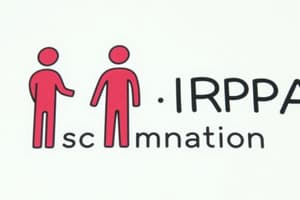Podcast
Questions and Answers
What is an allegation according to the policy?
What is an allegation according to the policy?
- An unproven assertion or statement based on a person's perspective that the policy has been violated (correct)
- A written or verbal report by a complainant alleging harassment and/or discrimination
- The legal obligation to take steps to eliminate disadvantage caused by systemic barriers
- A proven assertion of discrimination or harassment
Who is the complainant according to the policy?
Who is the complainant according to the policy?
- The person investigating the allegation
- The person alleging that discrimination or harassment occurred (correct)
- The person offended by the allegation
- The person responsible for taking steps to eliminate disadvantage
What is discrimination according to the policy?
What is discrimination according to the policy?
- Any practice or behaviour that has a positive impact on an individual or group
- Any practice or behaviour that is intentional and has a negative impact on an individual or group
- Any practice or behaviour that has a negative impact on an individual or group not protected in the Ontario Human Rights Code
- Any practice or behaviour, whether intentional or not, which has a negative impact on an individual or group protected in the Ontario Human Rights Code (correct)
What is the duty to accommodate according to the policy?
What is the duty to accommodate according to the policy?
What can arise from the unequal effect of treating individuals and groups in the same way?
What can arise from the unequal effect of treating individuals and groups in the same way?
What is a complaint according to the policy?
What is a complaint according to the policy?
What is the basis of discrimination according to the policy?
What is the basis of discrimination according to the policy?
What is the result of discrimination in terms of access to goods, services, facilities, employment, housing accommodation or contracts?
What is the result of discrimination in terms of access to goods, services, facilities, employment, housing accommodation or contracts?
What is the term used to describe the treatment that brings about an equality of results and may require different treatment in some instances?
What is the term used to describe the treatment that brings about an equality of results and may require different treatment in some instances?
Who is considered an employee under this policy?
Who is considered an employee under this policy?
What is an incident under this policy?
What is an incident under this policy?
What is incivility under this policy?
What is incivility under this policy?
What is the definition of harassment under the Ontario Human Rights Code?
What is the definition of harassment under the Ontario Human Rights Code?
What is an example of Code-based harassment?
What is an example of Code-based harassment?
Who is responsible for telling a harasser to stop?
Who is responsible for telling a harasser to stop?
What is not a form of harassment under this policy?
What is not a form of harassment under this policy?
What is the purpose of accommodation?
What is the purpose of accommodation?
What is failure to accommodate?
What is failure to accommodate?
What is the key factor in determining whether behaviour is considered harassment in the workplace?
What is the key factor in determining whether behaviour is considered harassment in the workplace?
What is an example of behaviour that is not considered workplace harassment?
What is an example of behaviour that is not considered workplace harassment?
What is the main difference between workplace harassment and workplace sexual harassment?
What is the main difference between workplace harassment and workplace sexual harassment?
What is an example of a behaviour that may be considered constructive feedback?
What is an example of a behaviour that may be considered constructive feedback?
What is the primary reason why a single incident of behaviour may be considered workplace harassment?
What is the primary reason why a single incident of behaviour may be considered workplace harassment?
What is not considered a legitimate reason for behaviour that may be considered harassment?
What is not considered a legitimate reason for behaviour that may be considered harassment?
Why is it important to consider the context of a behaviour when determining whether it is harassment?
Why is it important to consider the context of a behaviour when determining whether it is harassment?
What is the purpose of this policy on workplace harassment?
What is the purpose of this policy on workplace harassment?
Study Notes
Definitions
- An allegation is an unproven assertion or statement based on a person's perspective that the policy has been violated.
- A complainant is the person alleging that discrimination or harassment occurred, and there can be more than one complainant in a human rights complaint.
- A complaint is a written or verbal report by a complainant alleging that they have experienced or witnessed harassment and/or discrimination based on one or more of the grounds identified in the policy.
Discrimination and Harassment
- Discrimination is any practice or behavior that has a negative impact on an individual or group protected under the Ontario Human Rights Code, excluding, denying benefits, or imposing burdens upon them.
- Duty to accommodate is the legal obligation to take steps to eliminate disadvantage caused by systemic, attitudinal, or physical barriers that unfairly exclude individuals or groups protected under the Ontario Human Rights Code.
- Employee For the purpose of this policy, the term employee includes: City of Toronto employees, job applicants and individuals performing services directly on the City’s behalf whether with or without compensation or benefit, excluding individuals providing services by way of service provision/third party contracts – see section 2.3
- Equal treatment is treatment that brings about an equality of results and that may, in some instances, require different treatment. For example, to give all employees equal treatment in entering a building, it may be necessary to provide a ramp for an employee who requires the use of a wheelchair.
- Incident An incident is an event or occurrence in which discriminatory and/or harassing behaviour is exhibited in the workplace. An incident includes situations where an individual knows or ought to have reasonably known that the behaviour is contrary to this policy. An incident may not have to be raised to management directly by a complainant (e.g., a manager is aware of sexualized banter between workers through observation or this information is raised to the manager by a third party but no one has come forward to complain).
- Harassment is a form of discrimination that may result from a single significant incident or a series of incidents, and can occur between various individuals in the workplace.
- Incivility refers to conduct that is not harassment, characterized by rude, discourteous interactions that display a lack of regard for others.
Types of Harassment
- Code-based harassment is defined in the Ontario Human Rights Code as engaging in a course or conduct that is known or ought reasonably to be known to be unwelcome based on one or more of the prohibited grounds listed in the Code.
- Examples of Code-based harassment include:
- Slurs or derogatory remarks
- Threats
- Inappropriate jokes, innuendos, name-calling, teasing, embarrassing practical jokes
- Insulting gestures
- Displaying pin-ups, pornography, racist, homophobic or other offensive materials
- (Non-Code) Workplace harassment is harassment that is not related to a prohibited ground identified in the Ontario Human Rights Code, and includes:
- Vexatious comment or conduct against a worker in a workplace that is known or ought reasonably to be known to be unwelcome
- Workplace Sexual Harassment
- Examples of workplace harassment include:
- Frequent angry shouting/yelling or blow-ups
- Regular use of profanity and abusive language
- Verbal or e-mail threats
- Intimidating behaviors
- Targeting individual(s) in humiliating practical jokes
- Excluding, shunning, impeding work performance
- Spreading gossip, rumors, negative blogging, cyber-bullying
- Retaliation, bullying, sabotaging
- Unsubstantiated criticism, unreasonable demands
- Frequent insults and/or name calling
- Public humiliation
- Communication that is demeaning, insulting, humiliating, mocking
- Intent to harm
- A single, serious incident that has a lasting, harmful impact
- Workplace harassment does not include:
-
legitimate performance/probation management
-
appropriate exercise and delegation of managerial authority
-
operational directives/direction of workers or the workplace
-
other reasonable action(s) taken by management
-
a disagreement or misunderstanding
-
conflict between co-workers
-
work related change of location, co-workers, job assignment
-
appropriate discipline
-
less than optimal management
-
a single comment or action unless it is serious and has a lasting harmful effect
-
rudeness unless it is extreme and repetitive
-
incivility
-
conditions in the workplace that generate stress (technological change, impending layoff, a new boss, friction with other employees, workload, etc.).
-
Studying That Suits You
Use AI to generate personalized quizzes and flashcards to suit your learning preferences.
Description
This quiz covers the definitions of key terms related to human rights complaints, including allegations, complainants, and complaints.




